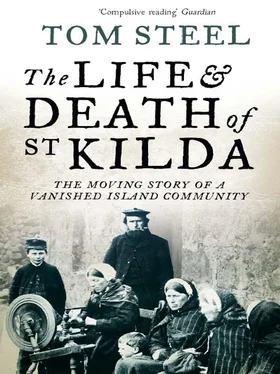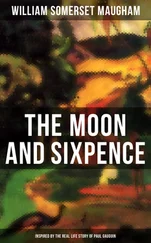The next day the nation’s newspapers told their version of the day’s events. In bold, black type one newspaper announced ‘EXODUS FROM ST KILDA! ISLANDERS LEAVE THEIR HOMES WITHOUT TEARS’. For many who wrote and read the morning papers on Saturday 30 August, the evacuation of St Kilda represented a victory for their society. The social anomaly in the Atlantic that had been an embarrassment to progress made elsewhere in Scotland had at long last been eradicated.
Until the evacuation St Kilda was the most remote inhabited part of the United Kingdom. It had been so for at least a thousand years, and as such the place fascinated those on the mainland. ‘It seems almost beyond credence’, wrote an astounded correspondent to The Globe newspaper in the middle of the nineteenth century, ‘that such an interesting little colony, such an exclusive commonwealth exists as part of this busy kingdom. Beyond the whirl of commercial life, untroubled by politics, completely isolated from the rest of the world, the St Kildan lives his simple life. When death comes to him he is quietly buried in the little paddock which does duty for “God’s acre”, among the familiar crags and hills; the wild sea birds sing his requiem and the Atlantic surges toll his funeral knell.’
St Kilda is the name not of one island but of an archipelago which lies in the Atlantic Ocean about 110 miles west of the Scottish mainland. The nearest island is Uist in the Outer Hebrides which is about 45 miles east of St Kilda. The nearest port from which boats are able to sail is Lochmaddy, some 65 miles from the group. Dunvegan on the Isle of Skye is 80 miles away and Castlebay on the island of Barra lies some 90 miles from St Kilda. The origin of the name ‘St Kilda’ is the subject of controversy. A Dutch map of 1666 is the first to refer to the little archipelago west of the Sound of Harris as ‘S. Kilda’. There is no reason to believe a saint called Kilda ever lived, and the islanders rarely referred to their home by that name. To the St Kildans the island of their birth was Hirta, and there is a map, issued in Italy in 1563, that plots an island called ‘Hirtha’ to the west of the Scottish mainland. But even this old Gaelic name is subject to scholarly debate. Many say it is derived from the old Irish word ‘Hiort’, meaning ‘death’ or ‘gloom’, a reminder of the old idea that the land of spirits lay beyond the sea. According to the Reverend Neil Mackenzie who was minister on St Kilda for fourteen years, the name was derived from the Gaelic ‘I’ (island) and ard (high). Perhaps, however, the origin of the name Hirta comes from the old Norse for shepherd – Hirt, a reference to the fact that the island almost rises perpendicular from the sea and overlooks the Western Isles.
The origin of the name St Kilda might also be found in the way in which the islanders pronounced Hirta. The natives pronounced an ‘r’ like an ‘I’, so that Hirta sounds like ‘Hilta’, or almost ‘Kilta’, as the ‘h’ had a somewhat guttural quality.
Hirta is the largest island of the group. The coastline measures some eight and three-quarter miles and the total land area is 1,575 acres. It has two bays: Glen Bay lies to the north-east of the island and Village Bay, where the people of documented history lived, lies to the south-west. The two cut deep into the land and shape it into a rough letter ‘H’.
Hirta can only be thought of as stupendous. In parts only one and a half miles long, and at no point more than one and three quarter miles across, the island has five peaks over nine hundred feet high. Of these, three – Mullach Mor, Mullach Bi, and Conachair – are over a thousand feet above sea level. Conachair rises to 1,397 feet, and its awe-inspiring cliffs are the highest in the British Isles.
Of the three other islands in the group, the island of Dun lies nearest to Hirta, to the western side of Village Bay. It is separated from the main island by a narrow channel, only fifty yards wide. Dun is a long, narrow finger of land which rises to over 570 feet above sea level as it stretches out into the Atlantic. The island is rocky and precipitous on its western side, grassy on its eastern flank, and in winter it was not unknown for the spray from waves to crash over the top of the island into Village Bay below.
Soay, the second largest island of the archipelago, lies to the north-west of Hirta. Abrupt on all sides of its two and a quarter mile coastline, Soay has a land area of 244 acres. Rising to 1,200 feet Soay, like Dun, is separated from Hirta by a narrow passage of ocean. Three needles of rock, Stac Donna (87 feet), Stac Biorach (240 feet), and Soay Stac (200 feet), stand in the sound.
Boreray, the remaining island, lies four miles to the north of Hirta. It has an area of 189 acres and is surrounded by a wall of rock which climbs from 300 to 1,245 feet above sea level. Lush grass grows on the steep south-westerly slope of Boreray facing Hirta.
The archipelago includes other giant rocks, called stacs, that rise out of the Atlantic like the tips of icebergs. Stac Levenish (203 feet) lies outside Village Bay; Mina Stac (208 feet) and Bradastac (221 feet) lie at the foot of the cliffs of Conachair. Stac an Armin, which rises to 627 feet and is the highest stac in the British Isles, and Stac Lee, eighty-three feet shorter, rise from the waters round Boreray. Stac Lee is the more impressive of the two, rising like a great tooth of solid rock out of the ocean. Together with Boreray, from which in ages past they broke free, the two stacs have frequently aroused comments similar to that made by R. A. Smith when he sailed to St Kilda in the yacht Nyanza in 1879. ‘Had it been a land of demons,’ he wrote, ‘it could not have appeared more dreadful, and had we not heard of it before, we should have said that, if inhabited, it must be by monsters.’
Until the coming of steamships in the nineteenth century, the journey to St Kilda even from the Hebridean ports was slow and perilous. In 1697, when the island’s historian Martin Martin visited the people of Village Bay, the voyage took several days and nights. There was only one type of vessel available – an open longboat rowed by stout men of Skye. It took sixteen hours of sailing and rowing before the crew caught their first glimpse of Boreray. ‘This was a joyful Sight,’ wrote Martin Martin, ‘and begot new Vigor in our men, who being refreshed with Victuals, low’ring Mast and Sail, rowed to a Miracle. While they were tugging at the Oars, we plied them with plenty of Aqua Vitae to support them, whose borrowed Spirits did so far waste their own, that upon our arrival at Boreray, there was scarce one of our Crew able to manage Cable or Anchor.’ It was left to the following day to row the few miles to Hirta.
The prevailing winds helped further to cut off the people of Village Bay from would-be visitors. On the northern, uninhabited side of Hirta, Glen Bay is exposed to northerly gales, while on the other side of the island Village Bay is open to winds that blow from the south-east and the south-west. Because of steep rock faces, Glen Bay was rarely used as a landing-place, except by a few stray trawlermen running before a storm. The majority of landings throughout the island’s history were confined to Village Bay.
Wind and tide frequently prevented a landing. A sudden storm could lash the sea into waves forty feet high and make disembarkation impossible. To add to the difficulty, any vessel larger than a longboat could not come close enough to enable people to be put ashore on the slippery rocks that were the only possible landing-place.
Around 1877 a simple jetty was built on Hirta to assist the landing of people and stores. Two winters later it was swept away in a storm. In 1901–2 a small concrete jetty was built by the Congested District Board at a cost of £600. It proved less than adequate. Its size was governed less by the needs of the St Kildans, and more by the money available at the time. Although well constructed it was little improvement on the previous state of affairs. It made for a more graceful landing but did not significantly increase the number of landings possible. Even to this day, only the four months of summer – May, June, July, and August – hold out hope of a landing for visitors. To set foot on Hirta depends to this day upon small boats and calm waters.
Читать дальше












